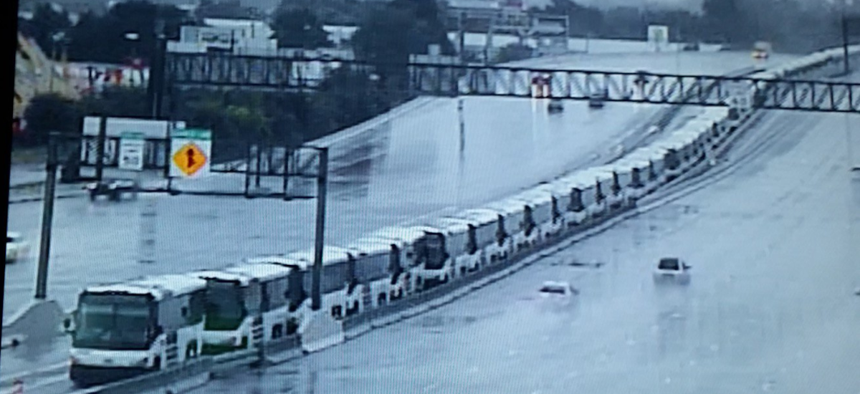Houston Metro Adapts Winter-Weather Tactic to Save Its Buses From Harvey’s Flooding

Harris County Metro lined up 120 buses on an elevated highway to save them from the floodwaters. Traffic camera image via Harris County Metro
A smart action by a transit agency is hailed as “a good move” during tropical storm.
When major winter storms hit the Northeastern U.S., the agencies that run the subways in New York City and the Washington, D.C.-area Metro system will move rail cars from vulnerable and exposed maintenance yards and relocate them underground for protection from the elements and being snowed-in or, in some cases, iced-in.
In New York, the subway system’s express tracks offer a good amount of storage space, while allowing the Metropolitan Transportation Authority to maintain reduced levels of service underground along the local tracks during winter storms or enough time to totally ramp down service before a service-crippling storm arrives.
In advance of Hurricane Harvey’s arrival in Texas, Harris County Metro, the transit agency that operates light-rail and bus service in the Houston area, had to figure out how to protect its buses parked in the low-lying Kashmere depot, located near the junction of Interstate 610 and Interstate 69, north of downtown.
So Metro moved them to a high-occupancy vehicle lane in the center of Interstate 69, which is elevated and safely out of reach from the floodwaters, and lined the buses up, 120 of them, one by one for “a literal mile (and then some),” the agency posted on Facebook on Saturday.
"It was a great move," Metro spokesman Jerome Gray told the Houston Chronicle on Monday.
Protecting transit vehicles in advance of and during inclement weather is critically important in order to get service restarted after a storm has passed, not to mention avoiding costs to repair or replace damaged rail cars and buses.
Not planning for that can be a costly mistake.
As The Washington Post reported, following Hurricane Katrina, restarting transit service in New Orleans was difficult due to hundreds of flooded buses.
When Hurricane Sandy pushed storm surge into the coastline, bays and inlets in the greater New York City area in 2012, low-lying New Jersey Transit rail yards in Hoboken and Kearny flooded, damaging a third of the commuter rail fleet. That hobbled the system for weeks after the storm, something that could have been avoided if locomotives and rail cars would have been moved to higher ground.
With Harvey’s floodwaters making many Houston-area roads impassible, Metro has suspended all regular transit service though buses are being used to shuttle residents to shelters and assist first responders with evacuations.
Michael Grass is Executive Editor of Government Executive’s Route Fifty and is based in Seattle.
NEXT STORY: What 35 Inches of Rain Can Dredge Up






